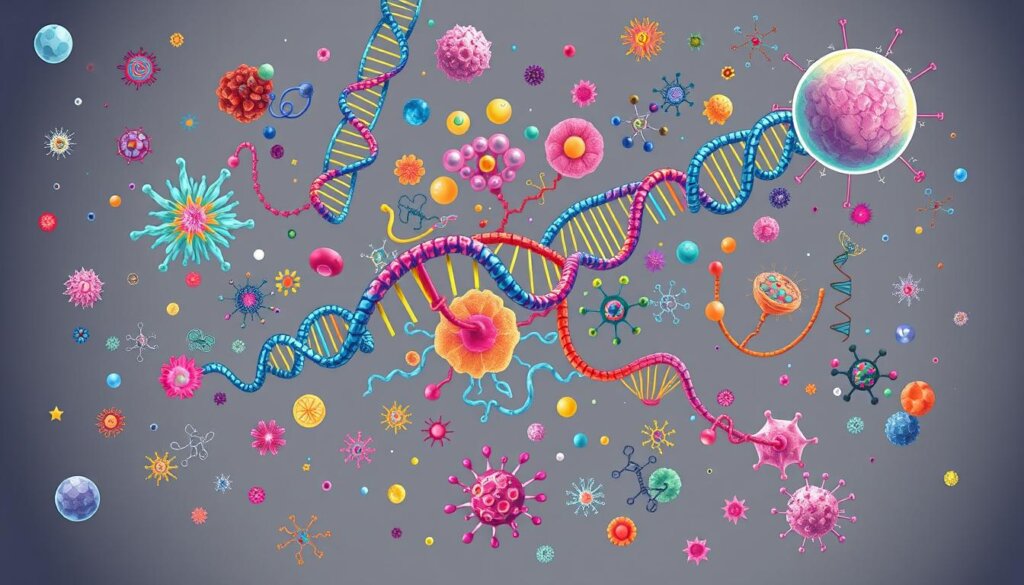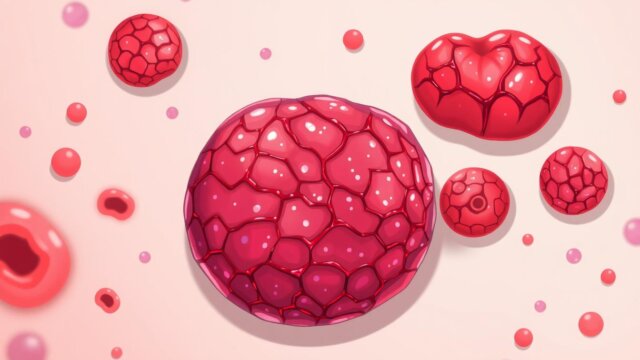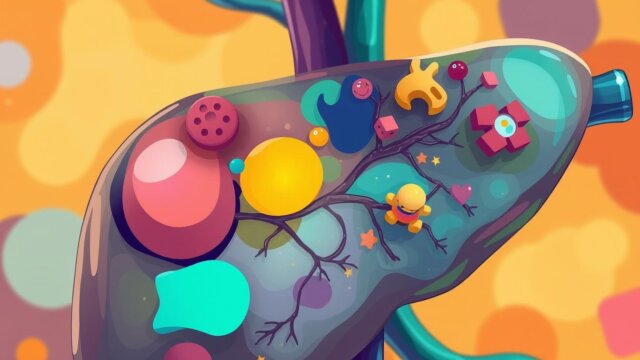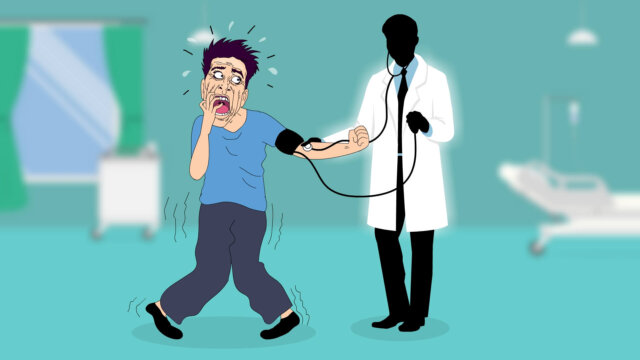FTC disclaimer: This post may contains affiliate links and we will be compensated if you click on a link and make a purchase.
Gastrointestinal stromal tumors (GISTs) are rare. They mostly happen in the stomach and small intestine. These tumors make up 0.1-3% of all cancers in the digestive system.
They grow from special cells called interstitial cells of Cajal. These cells help food move through the digestive tract. GISTs can show up anywhere in the digestive system. But they are the most common tumors of their kind in the GI tract.
Key Takeaways
- Gastrointestinal stromal tumors (GISTs) are a rare type of sarcoma that develops in the digestive system.
- GISTs predominantly occur in the stomach and small intestine but can arise anywhere along the GI tract.
- GISTs account for 0.1-3% of all gastrointestinal malignancies and are the most common mesenchymal tumors of the GI tract.
- GISTs can present with symptoms like abdominal pain, fatigue, nausea, vomiting, and gastrointestinal bleeding.
- Imaging tests and biopsies are used to diagnose and evaluate GISTs, while surgery and targeted drug therapy are the primary treatments.
What are Gastrointestinal Stromal Tumors?
Definition and Overview
Gastrointestinal Stromal Tumors (GISTs) are a kind of soft tissue sarcoma. They grow in the GI tract. These tumors start from cells that help food move through the digestive system.
GISTs can happen anywhere in the GI tract. But they mostly show up in the stomach (60%) or small intestine (20-30%).
Prevalence and Incidence
GISTs are quite rare, making up only 0.1-3% of GI cancers. Studies say about 6.5-14.5 people per million get GISTs each year. The rate is 0.68-0.8 per 10,000 after adjusting for age.
In Western Sweden, before imatinib therapy, there were 1-2 cases per 100,000 people yearly. The Icelandic GIST Study found 2.0 cases per million people from 1990-2003. In Spain, the rate was 8.8 per million person-years.

GISTs are most common in the stomach (56%), then the small bowel (32%). They also appear in the colon and rectum (6%), esophagus (0.7%), and other places (5.5%). Most GISTs aren’t caused by environmental factors or infections. But, some are due to genetic changes in the KIT and PDGFRA genes.
Causes and Risk Factors
Gastrointestinal stromal tumors (GISTs) are mainly caused by genetic mutations. These mutations often happen in the KIT and PDGFRA genes. About 85% of GIST cases without a known family history have these mutations. This leads to uncontrolled cell growth and tumor formation.
In some cases, these mutations can be passed down through families. This results in rare familial GIST syndromes.
Genetic Mutations
Most GIST cases are caused by random mutations. But, some people might be more likely to get these tumors because of their genes. Familial GIST syndrome is a rare condition caused by an abnormal KIT gene from a parent. Sometimes, a change in the PDGFRA gene can also cause it.
People with Neurofibromatosis type 1 also have a higher risk of GISTs. This is because of a defect in the NF1 gene.
Familial and Inherited Syndromes
Carney-Stratakis syndrome is another rare condition that raises the risk of GISTs. It’s linked to changes in the succinate dehydrogenase (SDH) genes. This can lead to GISTs, mostly in the stomach, and other nerve tumors.
People with Carney-Stratakis syndrome often get GISTs at a young age. This can happen in their teens or 20s. They might also have more than one GIST tumor.
Genetic Mutation or Syndrome | Percentage of GIST Cases | Key Characteristics |
|---|---|---|
KIT gene mutation | Approx. 80% | A most common cause of GIST can be inherited |
PDGFRA gene mutation | Approx. 10% | A less common cause of GIST can be inherited |
SDH gene mutations (Carney-Stratakis syndrome) | Approx. 5-7% | The rare inherited condition leading to GIST and other nerve tumors |
NF1 gene mutation (Neurofibromatosis type 1) | Unknown | Increased risk of GIST, mostly in the small intestine |
Most GIST cases are not inherited. But, rare syndromes can also cause these tumors. Knowing the genetic factors of GIST is key for diagnosis and treatment.

Symptoms of Gastrointestinal Stromal Tumors
Gastrointestinal stromal tumors (GISTs) can cause different symptoms. This depends on the tumor’s size and where it is in the GI tract. Small tumors might not cause any symptoms and are often found by accident during medical checks.
But, as the tumor gets bigger, symptoms can start. These include stomach pain or discomfort, a mass in the belly, and bleeding in the GI tract. Other symptoms are nausea, vomiting, feeling full after eating a little, and tiredness.
GISTs are fragile and can bleed easily into the GI tract. This can cause symptoms like vomiting blood, dark stools, or seeing blood in the stool. Slow bleeding can cause anemia, making you feel tired and weak over time.
- Abdominal pain or discomfort
- Palpable abdominal mass
- Gastrointestinal bleeding (leading to anemia and fatigue)
- Nausea and vomiting
- Early satiety and feeling of fullness after eating small amounts
- Vomiting blood, tarry stools, or visible blood in stools
- Anemia, tiredness, and weakness
Other symptoms of GISTs include trouble swallowing, losing weight, and blockages from big tumors. These can cause severe belly pain and vomiting. If a GIST ruptures, it can cause a hole in the GI tract, needing emergency surgery.
If you have long-lasting symptoms like belly pain and nausea, see a doctor. Finding and treating GISTs early can greatly improve treatment success and patient outcomes.

“GISTs are fragile tumors that can easily bleed into the gastrointestinal tract, leading to various symptoms like vomiting blood, tarry stools, or visible blood in stools.”
Symptom | Description |
|---|---|
Abdominal pain or discomfort | A common symptom experienced by GIST patients is often due to the tumor’s growth and location within the gastrointestinal tract. |
Gastrointestinal bleeding | GISTs can bleed easily, leading to symptoms like vomiting blood, tarry stools, or visible blood in the stool, as well as anemia and fatigue. |
Nausea and vomiting | These symptoms can occur due to the tumor’s location and size, which can obstruct the passage of food through the gastrointestinal tract. |
Early satiety and feeling of fullness | Patients may experience a feeling of fullness after eating only small amounts of food due to the tumor’s impact on the stomach or small intestine. |
Diagnosis and Evaluation
Diagnosing a GIST starts with a physical exam and looking at your symptoms. Imaging tests like CT scans, MRI scans, and endoscopic ultrasound (EUS) help find the tumor. They also check its size and how far it has spread. EUS is great for seeing the layers of the GI tract wall and guiding a biopsy.
To confirm a GIST diagnosis, a biopsy is needed. This can be done through EUS-guided fine needle aspiration or during surgery. The biopsy sample is then analyzed. It looks for specific cell types and proteins like KIT (CD117) or DOG1, which are signs of GIST.
Imaging Tests for GIST
- CT scans and MRI scans are often used to see and check GISTs.
- Barium X-rays, like barium swallow and barium enema, help spot problems in the digestive tract.
- PET scans are good for seeing if GISTs have spread and if treatments are working.
- Capsule endoscopy lets us see parts of the small intestine that are hard to reach with regular endoscopy.
Biopsy and Pathology of GIST
GISTs are defined by their cell types and how they look under a microscope. Almost all (95%) GISTs have a certain protein called CD117. They usually have normal-looking mucosa and smooth edges.
Diagnostic Approach | Key Findings |
|---|---|
Endoscopic Ultrasound (EUS) | Useful for visualizing the layers of the GI tract wall and guiding biopsy |
Biopsy and Pathology | Look for characteristic spindle or epithelioid cell morphology and positive staining for KIT (CD117) or DOG1 proteins |
Medical history, physical exams, imaging tests, and endoscopy are key in diagnosing GISTs.

“The sensitivity and specificity of distinguishing an intramural lesion from extramural compression using endoscopy alone is reported as 87% and 29%, respectively.”
Gastrointestinal Stromal Tumors Treatment
Treating gastrointestinal stromal tumors (GISTs) often means using surgery and drugs. The treatment plan varies based on the tumor’s size, location, and stage.
Surgery
For tumors that can be removed, surgery is the first step. Small tumors (less than 2 centimeters) without symptoms might just need regular checks. But, for bigger or harder-to-remove tumors, drugs like imatinib (Gleevec) are used first to make the tumor smaller.
Surgery is done in a way that’s less invasive, like laparoscopic or robotic-assisted methods. This helps reduce the impact on the patient.
Targeted Drug Therapy
When surgery isn’t possible, drugs become the main treatment. Drugs like imatinib, sunitinib, and tyrosine kinase inhibitors target the tumor’s genetic mutations. If these drugs don’t work, the dose might be changed or a different drug might be tried, like avapritinib or ripretinib.
In some cases, radiation therapy is used to help with symptoms, especially for pain in bone tumors.
Standard chemotherapy doesn’t work well for GISTs, so new treatments in clinical trials might be suggested. Also, bigger tumors or those in places other than the stomach have a higher chance of coming back. So, imatinib is often used after surgery to lower the risk of recurrence.
“The treatment of gastrointestinal stromal tumors requires a multidisciplinary approach, combining surgical expertise and targeted drug therapies to achieve the best outcomes for patients.”
Characteristic | Treatment Approach |
|---|---|
Localized, resectable GIST | Surgical removal of the tumor |
Larger or more advanced GIST | Neoadjuvant imatinib (Gleevec) to shrink the tumor before surgery |
Unresectable, metastatic, or recurrent GIST | Targeted drug therapies like imatinib, sunitinib, avapritinib, or ripretinib |
GIST with bone involvement | Radiation therapy for symptom management and pain relief |
Treating GISTs needs a team effort, combining surgery and drugs. Knowing the tumor’s details helps doctors choose the right treatment. This way, they can manage this rare cancer effectively.
Prognosis and Follow-up Care
The GIST prognosis varies a lot. It depends on the tumor’s size, location, and how aggressive it is. Studies show that small, less aggressive GISTs have a great GIST survival rate. Their 5-year survival rate is over 90%. But, bigger, more aggressive GISTs have a worse prognosis. Their 5-year survival rate is around 50%.
It’s very important for GIST patients to have regular GIST follow-up care. This care includes imaging tests like CT scans and MRI, and doctor visits. How often you need to go for these tests depends on your GIST recurrence risk. People at higher risk need to go more often.
The goal of this care is to catch any GIST recurrence or growth early. This way, doctors can treat it quickly.
GIST Stage | 5-Year Survival Rate |
|---|---|
Localized GIST | 95% |
Regional GIST | 84% |
Distant GIST | 52% |
All SEER Stages Combined | 85% |
The GIST prognosis and GIST recurrence risk can also be influenced by the tumor’s genetics and how it responds to treatment. By being careful and following the right GIST follow-up care plan, doctors can help GIST patients do well.
“Regular monitoring and follow-up care are essential for managing GISTs, as the risk of recurrence can persist even years after initial treatment.”
In summary, the GIST prognosis depends a lot on the tumor’s details. Smaller, less aggressive tumors have much better GIST survival rates than bigger, more aggressive ones. It’s very important to have regular GIST follow-up care. This includes imaging and doctor visits to catch any GIST recurrence early. This helps improve patient outcomes.
Gastrointestinal Stromal Tumors in Specific Locations
Gastrointestinal Stromal Tumors (GISTs) can grow in the digestive tract. They most often show up in the stomach (60%) or small intestine (20-30%). They can also appear in the colon (3%), rectum (3%), esophagus (0.7%), or even outside the GI tract.
The place where a GIST grows can change how it feels and how it’s treated. For example, gastric GISTs tend to have a better outlook than small intestine GISTs. Esophageal and rectal GISTs might need more complex surgery.
GISTs can be of different sizes. 7% are less than 2 cm, 29% are between 2-5 cm, 36% are between 6-10 cm, and 28% are over 10 cm. Most GISTs are well-differentiated (38%) or moderately differentiated (32%). Only 19% and 12% are undifferentiated and poorly differentiated, respectively.
GIST Location | Percentage of Cases |
|---|---|
Stomach | 60% |
Small Intestine | 20-30% |
Colon | 3% |
Rectum | 3% |
Esophagus | 0.7% |
GISTs are rare, affecting 10-15 cases per million worldwide. They make up 1-2% of all GI tract cancers. Most GIST patients are between 60-74 years old, with a slight male to female ratio of 1.1:1.
It’s important to spot and treat GISTs quickly. The 5-year survival rate for GIST patients is 74%, and the 5-year cause-specific survival rate is 82%. Poorer survival rates are linked to tumor size over 5 cm, poor or undifferentiated grade, age over 60, and distant metastases at first.
“GISTs are a rare and unique type of cancer that require specialized care. Early detection and personalized treatment are essential for the best outcomes.”
The number of GIST cases has been going up, with a 5.3% annual increase from 2000-2018. Better diagnostic tools and targeted treatments have helped improve GIST patient outcomes.
Prevention and Screening
There’s no way to stop GISTs from happening because they come from random genetic changes. But, if you have a family history of GIST, genetic tests can find the cause. This helps understand your risk.
Most people don’t need regular checks for GIST because they’re small and might not show symptoms. Yet, those at high risk might get scans to find tumors early. This can lead to better treatment and outcomes.
There’s no one-size-fits-all approach to GIST screening. But, talking to your doctor about tests and risks is key. Being informed helps manage your risk and find tumors early.
GIST Prevention and Screening Strategies | Recommendations |
|---|---|
Genetic Testing | Recommended for individuals with a family history of GIST or known genetic syndromes associated with GIST |
Screening and Surveillance | Generally not recommended for the general population, but may be considered for high-risk individuals |
Imaging Tests | CT scans, MRIs, and other imaging tests may be used for periodic monitoring of high-risk individuals |
Even though you can’t prevent GISTs, knowing about tests can help manage your risk. Working with your doctor is crucial for your health and well-being.
Conclusion
Gastrointestinal stromal tumors (GISTs) are rare but serious. They often appear in the stomach and small intestine. Thanks to new treatments, many patients now have better chances of recovery.
Knowing about GIST is key. It helps doctors find and treat the disease quickly. This leads to better health outcomes for patients.
GISTs are caused by genetic changes in the KIT or PDGFRA genes. They can cause symptoms or not show any signs at all. Tests like CT scans and MRI help doctors find and understand GISTs.
Biopsy and lab tests tell doctors more about the tumor. Treatment includes surgery and special drugs. This approach has greatly improved how GISTs are managed.
Research is ongoing to find better ways to prevent and treat GISTs. Keeping up with new research helps doctors give patients the best care. This improves the lives of those with GIST.
FAQ
What are gastrointestinal stromal tumors (GISTs)?
GISTs are rare tumors in the digestive system. They often start in the stomach or small intestine. These tumors grow from special cells that help food move through the digestive tract.
How common are GISTs?
GISTs are rare, making up 0.1-3% of all tumors in the digestive system. Studies show they affect 6.5-14.5 people per million each year. The rate is about 0.68-0.8 per 10,000 people.
What causes GISTs?
Most GISTs come from mutations in the KIT or PDGFRA genes. This leads to uncontrolled cell growth. About 85% of GISTs have these mutations. The rest have other genetic changes.
What are the symptoms of GISTs?
Early GISTs might not cause symptoms. But as they grow, symptoms like pain and bleeding can appear. Other signs include nausea, vomiting, and feeling full quickly.
How are GISTs diagnosed?
Doctors start with a physical exam and symptom check. Imaging tests like CT scans help find and size the tumor. A biopsy confirms the diagnosis.
How are GISTs treated?
For small tumors, surgery is the main treatment. For bigger tumors, drugs like imatinib are used first. These drugs make the tumor smaller. For tumors that can’t be removed, drugs are the main treatment.
What is the prognosis for patients with GISTs?
The outlook depends on the tumor’s size and aggressiveness. Small, less aggressive tumors have a good prognosis. But bigger, more aggressive tumors have a poorer outlook. Regular check-ups are key to catch any changes.
Can GISTs be prevented or screened for?
There’s no way to prevent GISTs. They come from genetic mutations that are often random. Genetic testing is suggested for those with a family history. But regular screening is not advised for everyone.








